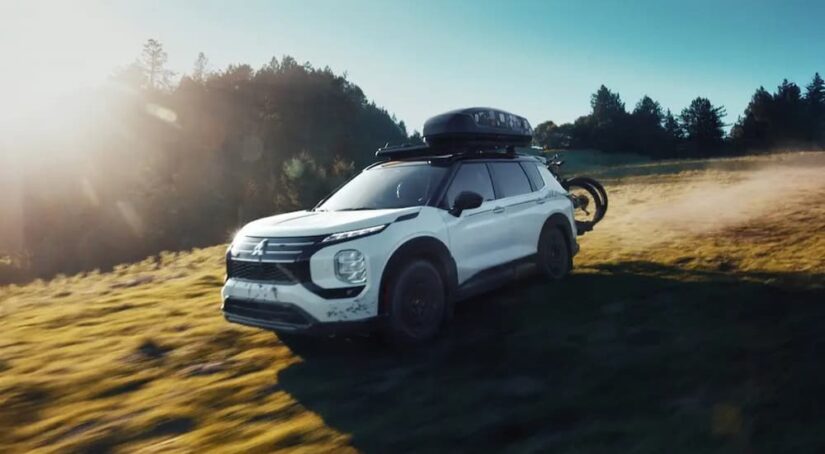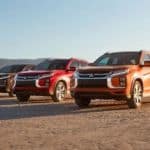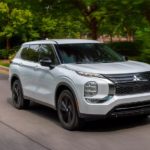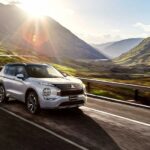The Mitsubishi Outlander is a study in contrasts. While technically classified as a compact crossover, the SUV defies its diminutive designation to offer the only three-row setup in the segment. The Outlander is also notable for its affordability, with a starting price below $30,000, yet it manages to offer a premium interior that wouldn’t be out of place on a vehicle that costs twice as much. Available as both a gas-powered model and a plug-in hybrid electric vehicle (PHEV), the Outlander regularly outsells the rest of the Mitsubishi lineup by a wide margin.
It’s easy to see why this crossover constantly tops the sales charts, and it’s hard to imagine a compact that’s better suited to the rigors of family life with seating for up to seven passengers. Throw in some impressive efficiency, ample cargo room, and all those little bells and whistles that make such an impact on the daily driving experience, and it’s tough to understand why the Outlander isn’t a more popular choice. Join us as we outline some of the highlights of Mitsubishi’s three-row compact crossover, ascend the trim ladder, and learn how Mitsubishi is aiming to remain competitive in an ever-changing auto market.
Maintaining Mitsubishi in the U.S.
Mitsubishi’s fortunes have changed pretty dramatically over the last 20 years. The early 2000s marked the automaker’s heyday in the North American market, but sales quickly eroded as the Japanese outfit failed to establish a robust dealership network and dealt with increased competition from its compatriots in Toyota, Honda, and Nissan. The company faced an 83 percent sales decline between 2002 and 2012, and made some significant changes to right the ship.
Mitsubishi moved away from the sports cars and sedans that defined its early U.S. offerings and embraced the only sure thing in today’s auto industry: the crossover SUV. The Outlander is easily the brand’s best-selling vehicle, combining with the Outlander PHEV to represent almost half of all U.S. sales. The subcompact Outlander Sport and compact Eclipse Cross round out the rest of the current lineup, leaving Mitsubishi with just four models as the Mirage compact car was discontinued following the 2024 model year.
Amid all this upheaval, the Outlander represents a bright spot for the beleaguered brand. The crossover’s sheer versatility and class-defying features have made the compact SUV popular among drivers seeking a value-packed vehicle. The Outlander hit a new high point in 2024, logging its best sales to date with over 45,000 units sold. Sure, that’s a drop in the bucket compared to models like the Toyota RAV4, which logged 475,193 sales in the same year, but it’s still an encouraging sign for a company that was rumored to be leaving the U.S. entirely as recently as 2020.
While the Outlander is propping up sales for now, a larger plan is being developed to keep Mitsubishi competitive in the North American market. Known as Momentum 2030, the plan includes a four-point approach to curb slumping sales and reassert the brand’s presence in the U.S.. It all starts with expanding both the brand’s dealership network and lineup, with Mitsubishi aiming to add one new or entirely refreshed model every year from 2026 to 2030. Hybrid, plug-in hybrids, and battery electric vehicles will play an increasingly important role in the company’s future, starting with a new battery electric vehicle based on the Nissan Leaf that’s set to hit dealers in 2026. If all goes to plan, half of Mitsubishi’s sales will come from EVs by 2030, with a fully electric lineup slated for 2035. It’s an ambitious goal, and would be a little far-fetched if not for the automaker’s membership in the Renault-Nissan-Mitsubishi Alliance. By working together, these three brands can pool resources and reduce development costs, allowing each automaker to increase its chances of succeeding in an increasingly competitive auto market.
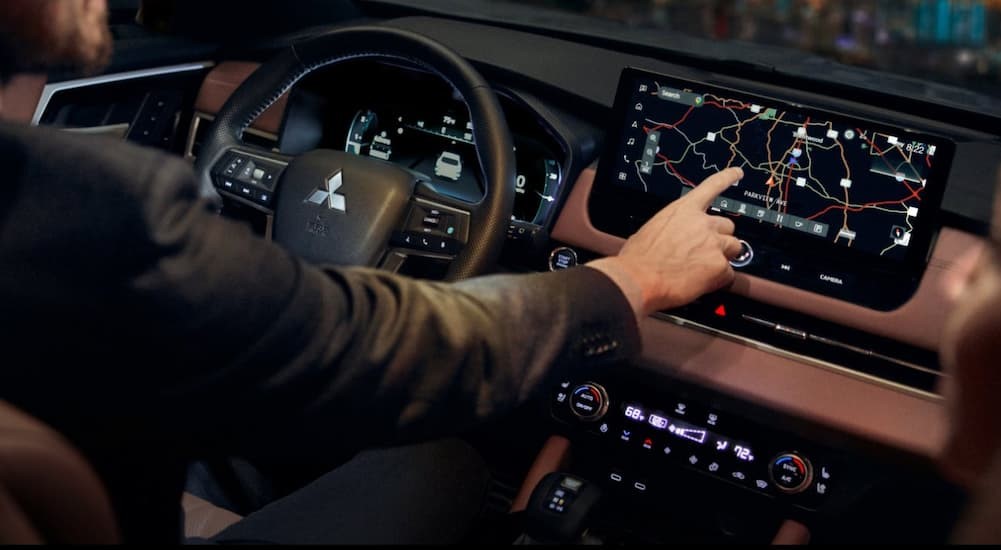
Room for the Whole Family and Their Gear
The Outlander certainly doesn’t feel like a compact from the front row, where the driver and passenger will both enjoy 40.6 inches of headroom and 41.7 inches of legroom. Things are a little cozier in the second row, but not as cramped as some might imagine, with the Mitsubishi offering 39.1 inches of headroom and 39.9 inches of legroom. Those are pretty generous dimensions for a compact crossover, and should allow adults and growing teens to stretch out, relax, and enjoy the ride comfortably. The second row seats also fold flat, allowing owners to take advantage of every cubic foot of cargo room. Passengers will even be treated to their own adjustable climate control system when opting for the SEL and Platinum trims.
In the third row, buyers won’t be surprised to learn that the legroom comes at a premium with the Outlander’s back seats limited to just around 18.7 inches. When you stop to think about it, that’s still infinitely more space than the nonexistent third row on every other compact SUV. Adults could theoretically squeeze into the third row, but unless you’ve got some contortionists in the family, they probably won’t be happy about it. The back row was designed with kids in mind, and serves that purpose to make the Outlander one of the most practical and affordable three-row models on the modern market.
One might think that the Outlander’s above-average capacity would have a detrimental effect on the SUV’s cargo room, but that’s not the case. Mitsubishi’s compact model is just as spacious as any other SUV in its class, despite being able to seat two extra passengers. Things might get a little tight with all three rows in use as the Outlander’s cargo capacity is reduced to just 10.9 cu.ft., but flip down the back seats and you have a crossover that ranks right in the middle of the segment with 64.3 cu.ft. available. That figure allows the Outlander to easily outpace some of its compact rivals like the Mazda CX-5 (59.6 cu.ft.) and Ford Mustang Mach-E (59.7 cu.ft.) while easily eclipsing these models in terms of how many riders it can accommodate.
A Solid Performance
The Mitsubishi Outlander comes in two distinct flavors: the standard internal combustion model and a PHEV version that ups the ante in terms of both performance and efficiency. The gas-powered Outlander is powered by a 2.5L I-4 engine that’s rated to produce a nice, even 181 hp and 181 lb-ft. of torque. Available in both front-wheel drive and all-wheel drive configurations, the traditional Outlander distributes its power through a continuously variable transmission that brings some real benefits in terms of fuel economy. The engine delivers an EPA-estimated 24 MPG in the city and 30 MPG on the highway for the AWD model, while the FWD version returns up to 31 MPG in the city. Most drivers don’t gravitate towards the compact crossover segment with big towing plans in mind, but if you do need to haul a little freight, the Outlander can pull up to 2,000 lbs when paired with the proper equipment.
The Outlander Hybrid leverages a little electrical assistance to raise the bar in terms of performance with two electric motors and a 2.4L I-4 combining to produce 248 hp. That’s almost a 40 percent improvement on the non-hybrid model, and proves that the eco-conscious tech can also offer some real benefits in terms of raw power. It’s quite efficient at 64 MPGe, and even offers 38 miles of all-electric range, but the hybrid also leaves the traditional model in the dust when it comes to a flat-out sprint. The Outlander Hybrid has the ability to speed from zero to 60 mph in 6.6 seconds, which is a huge improvement over the non-hybrid’s 8.2 seconds. The PHEV model does sacrifice 500 lbs of towing capacity in the name of its improved efficiency and performance, but it also boasts much lower fuel costs with an average annual expenditure of $1,400 to the gas model’s $1,800.
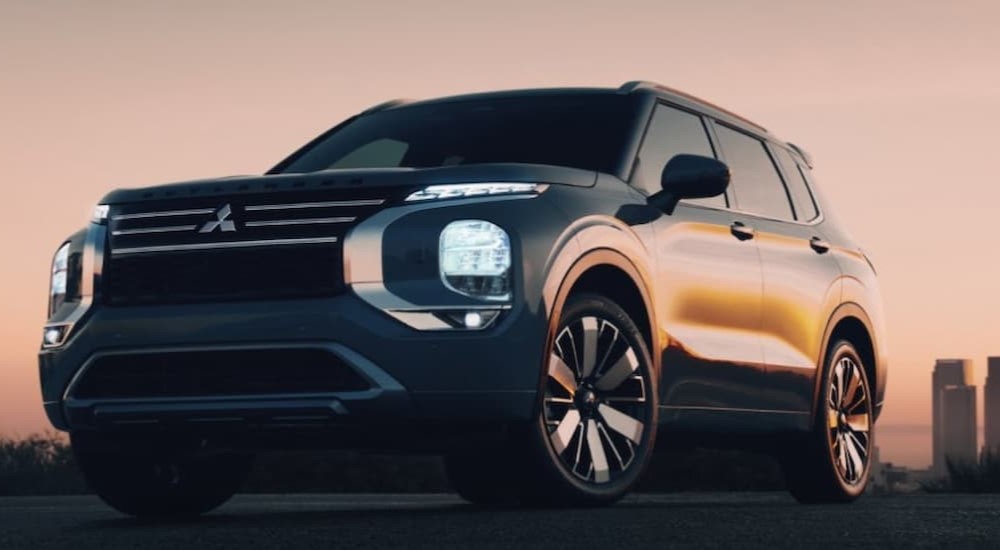
An Interior Monologue
The Outlander’s interior features an impressive arsenal of standard comfort and convenience tech and slick styling, regardless of which trim you choose. This marks a pleasant departure from other brands that tend to limit premium features to higher-end models, making Mitsubishi’s crossover one of the best values in the segment. Just take the base ES trim, for example. Offering everything from a push-button start and heated front seats to a dual-zone automatic climate control system and LED headlights, the ES is tough to beat when it comes to standard tech. The trim also offers plenty of modern infotainment features, including a 12.3-inch touchscreen display, Apple CarPlay and Android Auto smartphone integration with wireless connectivity, and a Yamaha audio system with a generous eight-speaker array.
The Outlander’s SE trim adds some important convenience tech like keyless entry, a power liftgate, and a wireless phone charger that’ll keep your smartphone juiced up and ready to go, but it’s the front row that sees the most significant upgrades. The SE offers heated front seats and a power-adjustable driver’s seat, both of which are wrapped in synthetic leather upholstery that lends the SUV some luxury appeal. An optional Tech Package throws a digital instrument panel and a panoramic sunroof into the mix, and swaps out the eight-speaker stereo for a 12-speaker Yamaha system that’s perfect for enjoying your favorite road trip playlist.
The SEL comfort-enhancing features make it stand out with its upgraded exterior trim. Both the front and rear seats gain a heating function and genuine leather upholstery, not to mention a ventilation feature for the front row and a power-adjustable front passenger seat. The Outlander’s three-zone automatic climate control system ensures everyone stays comfortable during the journey, and the rear seat window shades will keep passengers from soaking up too much sun during the warmer months. Finally, there’s the Platinum Edition, which adds a few sporty styling touches to the crossover in the form of black exterior paint with silver roof, a light gray interior, and silver gauge trim. The Platinum Edition’s most novel feature would have to be the puddle lights, which illuminate the ground next to the vehicle’s front doors when locking or unlocking the vehicle. It might seem like a minor detail, but if it keeps you from slipping on one patch of ice or avoiding one puddle, it’s money well spent.
Over and Outlander
Mitsubishi might not have the biggest footprint on the U.S. market, but the Outlander proves that the quality of the vehicles, not the size of the lineup, really matters. Today’s crossover segment can be a little homogenous, with every brand churning out nearly identical models. It’s an understandable approach in a traditionally risk-averse industry, but the results can often be underwhelming at best and boring at worst. By forging its own path and refusing to stick to the established formula, Mitsubishi has managed to craft one of the industry’s most enticing SUVs while keeping the Outlander’s price well within the reach of the average driver. The compact’s three-row design is the perfect example of the automaker’s original approach to the segment, and makes the SUV one of the best people-movers in the segment with seating for up to seven passengers. Mitsubishi could be making some big movies in the near future with its Momentum 2030 plan, especially if it manages to replicate the success that it’s found with the Outlander.
